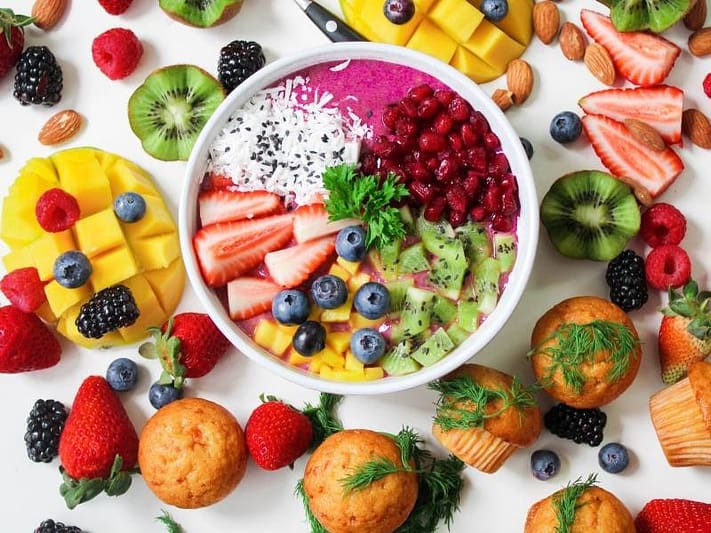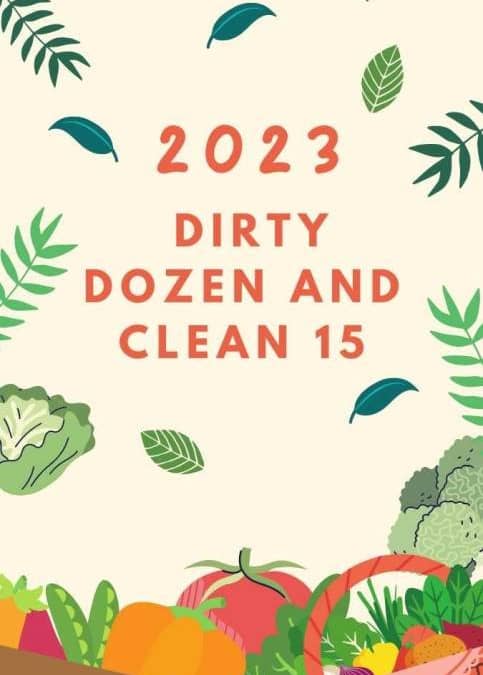Vegan Globetrotter is supported by our audience. When you purchase through one of our links, we may earn a small affiliate commission. As an Amazon Associate I earn from qualifying purchases. Your cost is not affected.
==================
The 2023 Dirty Dozen and Clean 15 lists fruits and vegetables ranked based on their levels of pesticide residue. Environmental Working Group (EWG) is a non-profit organization. They advocate for healthier living and a cleaner environment. So EWG releases 2023 Dirty Dozen and Clean 15 every year.
Environmental Working Group (EWG) implemented the Shopper’s Guide to Pesticides in Produce. It educates customers about the risks associated with insecticide or weed-killer exposure. They assist them in making more educated purchasing decisions. The “Dirty Dozen” list identifies the 12 fruits and veggies with high pesticide levels. It determines the guide’s product ranking based on pest-killer contamination levels. Hence, the “Clean Fifteen” ranks the top 15 produce items with low levels of toxic residue.
2023 Dirty Dozen
Modern agriculture adopted the widespread use of pesticides. This is to increase crop yield and control parasites. These chemicals can harm human health and the environment. It is especially about when it comes to the daily products we consume. Many farmers and other growers use toxic substances on Fruits and vegetables. This is to protect them from insects, fungi, and other pests. But the residues can wind up in our food and pose a health risk. Thus, the following harmful substances are detected in the following fruits and veggies:
Strawberries
Strawberries are among the most consumed fruits with carbendazim and bifenthrin. Fungicide carbendazim could change how the body makes its hormones. Bifenthrin is an insecticide that can cause fatigue, lethargy, and vertigo symptoms.
Spinach
Spinach is a popular leafy vegetable with chemicals. It has permethrin and DDT because of its high nutritional value. Seizures, migraines, and skin irritation are some side effects. It is neurotoxic insecticide permethrin. Once used, the pesticide DDT has persisted in the environment for decades after it is not used again. Moreover, DDT exposure has a connection to cancer, delayed development, and other health issues.
Kale, Collards, and Mustard
Chlorpyrifos and DCPA are common treatments for these trendy edible plants. They prohibit neurotoxicity and chlorpyrifos as household pesticides in the United States. DCPA, also spelled “Dacthal,” is a chemical connected to cancer and is harmful to the liver and other organs.
Peaches
Peaches are a luscious fruit often treated with azinphos-methyl and iprodione. It keeps its succulent and sweet flavor while protecting it from pests. Because of its neurotoxic properties, the insecticide azinphos-methyl. It can cause to experience symptoms like nausea, dizziness, and migraines. Still, Iprodione is a fungicide that disrupts hormone synthesis in humans and other animals.
Pears
Carbaryl and diphenylamine preserve various fruits, including pears. Tremors, convulsions, and other nervous system issues are all possible side effects of carbaryl, a neurotoxic insecticide. Also, there is evidence linking diphenylamine, a potential carcinogen, to bladder cancer.

Nectarines
Chlorpyrifos and bifenthrin are to nectarines applied because of their similarity to peaches. They restricted chlorpyrifos as a household pesticide in the United States. Bifenthrin is a neurotoxic insecticide that can affect the nervous system. It can lead to symptoms like fatigue, weakness, and even vertigo.
Apples
Thiabendazole and phosmet treat apples, one of the world’s most consumed foods. As a pesticide, thiabendazole can affect male and female fertility. Phosmet, a neurotoxic insecticide, can impact the central nervous system. It can lead to symptoms like these when exposed to it.
Grapes
Chlorpyrifos and dimethoate are common pesticides used on grapes. They outlawed chlorpyrifos as a household chemical in the United States. Research suggests that dimethoate may be carcinogenic and cause various other health issues.
Bell and Hot Peppers
Peppers, both sweet and hot, use in cooking and enjoy by people all over the globe. To make matters worse, they use chemicals that can be dangerous to people. They used insecticides like acephate on these. It can harm the nervous system if consumed or inhaled in large quantities. Another herbicide the EPA considers carcinogenic is methomyl, which is used on peppers. Headaches, vertigo, and nausea are some of the side effects. This pesticide is because of its neurotoxicity.
Cherries
Cherries are a popular and delicious fruit. Unfortunately, they are often sprayed with chemicals that can harm human health. The EPA classifies the used insecticide azinphos-methyl as a toxic chemical. It can damage the nervous system. The pesticide imidacloprid is also discovered in cherries. It can also be an endocrine disruptor. Because of this, it poses a threat to human health. It disrupts hormones’ natural function.
Blueberries
Blueberries’ antioxidants and other beneficial nutrients have made them famous and healthy fruit. To make matters worse, they use chemicals that can be dangerous to people. Malathion, as a neurotoxic pesticide, has a connection to its side effects. Another pesticide suspected of disrupting hormone systems is propiconazole, discovered in blueberries. Serious health problems may arise from this toxic chemical. The potential to disrupt regular hormonal function may occur.
Green Beans
Green beans have chemicals that can be dangerous to people. The insecticide acephate, used on green beans, is neurotoxic. If consumed or inhaled in significant quantities, it causes adverse effects. Green beans are a frequent source of the pesticide dimethoate, which is carcinogenic. Headaches, vertigo, and nausea are some of the side effects of this pesticide.
@EWG experts explain the toxic pesticides used on food crops in this video. Learn how to limit exposure with 2023 Dirty Dozen and Clean 15.
2023 Clean 15
The Clean 15 is a group of produce items determined to have fewer pesticide residues. The Clean Fifteen lists 15 fruits and vegetables with the fewest pesticide residues. The Environmental Working Group (EWG) compiled this Clean 15. It will be their yearly Shopper’s Guide to Pesticides in Produce. Some foods on the list are resistant to pests and diseases—sweet corn and papaya-modified seeds that need fewer pesticides. Clean 15 is a valuable resource for consumers who focus on health and sustainability.
Avocados
Avocados are one of the few fruits and veggies that can be grown with fewer pesticides. They are a fantastic option for those who want to limit their toxic exposure. They have thick skin is a second line of defense against lingering chemicals.
Sweet Corn
Most available sweet corn is in the United States. It modified seeds resistant to pests and required fewer pesticides. The lack of chemicals in sweet corn makes it healthy. This is an option for those who want to reduce their chemical exposure.
Pineapple
Its thorny leaves deter pests. Pineapples can have fewer chemical pesticides.
Onions
Onions are resistant to pests and diseases. They are usually grown using fewer pesticides than other edible plants.
Papaya
Most of the papaya distributed in the United States comes from Hawaii. It is because they limit the use of pesticides. Because of this, papaya is a healthy option for people who want to cut back on their chemical intake.
Sweet Peas
Fewer pesticides to cultivate frozen sweet peas than in producing other veggies. They have frozen shortly after harvest.
Asparagus
Its resistance to pests and diseases needs fewer pesticides in its cultivation. For this reason, it’s an excellent option for those who want to cut their contact with pesticides.
Honeydew Melon
The thick rind of honeydew melons is a natural pest deterrent. Thus, farmers can use fewer pesticides on them than on other crops.
Kiwi
Kiwis are immune to many common pests and diseases. Hence, this feature makes them a good candidate for organic farming.
Cabbage
It has resistance to insects and diseases. Cabbage requires fewer pesticides in its cultivation than many other veggies. For this reason, it’s an excellent option for those who want to cut their contact with pesticides.
Mushrooms
Many pesticides are not found in mushrooms. They are usually grown in controlled environments indoors. Because of this, they are a safe option for people who want to limit their contact with toxic chemicals.
Mangoes
Mangoes are immune to many common pests and diseases. So they use fewer pesticides in their cultivation.
Sweet Potato
It has a natural resistance to insects and diseases. Sweet potatoes need fewer pesticides during cultivation.
Watermelon
A watermelon’s thick rind is a natural pest deterrent. The farmers use fewer chemicals on it than on other crops.
Carrots
The Carrot plant is resistant to many common veggie pests and diseases. Farmers can avoid using fewer pesticides when growing carrots.
Have You Learned the 2023 Dirty Dozen and Clean 15?
Consumers should be aware of the risks of pesticide exposure. Select foods with lower pesticide residue levels whenever workable. A diet rich in fruits and vegetables is essential for good health. The guide suggests that readers buy organic versions of fruits and veggies. It limits their exposure to dangerous pesticides. They also advocate more stringent restrictions on pesticide use in this pro.
You’ve probably appreciated our lists for fruits and veggies if you’re concerned about what you put into your body and the state of the world. Lists like this can help you avoid eating produce that has been heavily treated with pesticides. If you want to make educated decisions about what to buy in the supermarket or farmers’ market, keep an eye out for these lists. This is an early step in the right direction toward a greener, longer-lasting way of living! Thanks for reading and we look forward to seeing you once more in our other blog posts!
More Interesting Stuff!
Safe Organic Foods To Eat After a Heart Attack
Best Superfoods to Add to Smoothies
Frequently Asked Questions – 2023 Dirty Dozen and Clean 15






Don't miss out
when new recipes and information are added!
Join our newsletter for free recipes,
healthy living inspiration, and special offers
You have Successfully Subscribed!